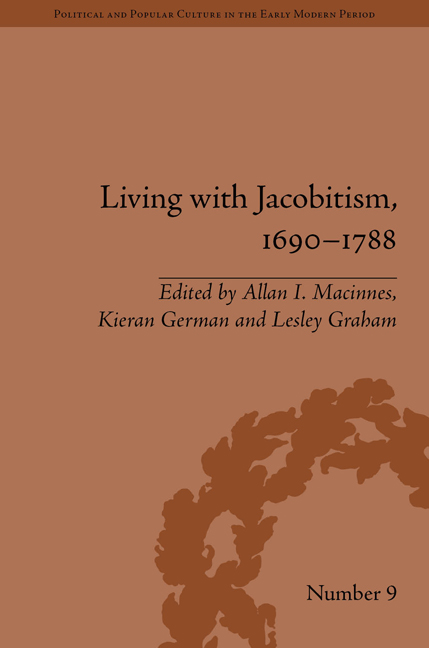Book contents
- Frontmatter
- CONTENTS
- List of Contributors
- List of Figures
- Abbreviations
- Preface: Breandán Ó Buachalla, A Tribute
- Introduction: Living with Jacobitism
- 1 The First Jacobite and the Scottish Parliament
- 2 The Scottish Jacobite Community at Saint-Germain after the Departure of the Stuart Court
- 3 Liturgy: The Sacramental Soul of Jacobitism
- 4 ‘Zealous in the Defence of the Protestant Religion and Liberty’: The Making of Whig Scotland, c. 1688–c. 1746
- 5 Jonathan Swift's Memoirs of a Jacobite
- 6 ‘Female Rebels’: The Female Figure in Anti-Jacobite Propaganda
- 7 Commerce and the Jacobite Court: Scottish Migrants in France,1688–1718
- 8 Ultramontane Ultras: The Intellectual Character of Irish Students at the University of Paris
- 9 To a Fair Meeting on the Green: The Order of Toboso and Jacobite Fraternalism, 1726–c. 1739
- 10 English and Scottish Jacobite Painters in Eighteenth-Century Rome
- 11 Polite War: Material Culture of the Jacobite Era, 1688–1760
- 12 Robert Adam: ‘My Mother's Dear British Boy’
- 13 From Jacobite to Jacobin: Robert Watson's Life in Opposition
- 14 Robert Louis Stevenson's ‘The Young Chevalier’: Unimagined Space
- Notes
- Index
14 - Robert Louis Stevenson's ‘The Young Chevalier’: Unimagined Space
- Frontmatter
- CONTENTS
- List of Contributors
- List of Figures
- Abbreviations
- Preface: Breandán Ó Buachalla, A Tribute
- Introduction: Living with Jacobitism
- 1 The First Jacobite and the Scottish Parliament
- 2 The Scottish Jacobite Community at Saint-Germain after the Departure of the Stuart Court
- 3 Liturgy: The Sacramental Soul of Jacobitism
- 4 ‘Zealous in the Defence of the Protestant Religion and Liberty’: The Making of Whig Scotland, c. 1688–c. 1746
- 5 Jonathan Swift's Memoirs of a Jacobite
- 6 ‘Female Rebels’: The Female Figure in Anti-Jacobite Propaganda
- 7 Commerce and the Jacobite Court: Scottish Migrants in France,1688–1718
- 8 Ultramontane Ultras: The Intellectual Character of Irish Students at the University of Paris
- 9 To a Fair Meeting on the Green: The Order of Toboso and Jacobite Fraternalism, 1726–c. 1739
- 10 English and Scottish Jacobite Painters in Eighteenth-Century Rome
- 11 Polite War: Material Culture of the Jacobite Era, 1688–1760
- 12 Robert Adam: ‘My Mother's Dear British Boy’
- 13 From Jacobite to Jacobin: Robert Watson's Life in Opposition
- 14 Robert Louis Stevenson's ‘The Young Chevalier’: Unimagined Space
- Notes
- Index
Summary
‘The Young Chevalier’ is the fragment of a novel written in 1892 and first published posthumously in volume 26 of the Edinburgh Edition of the works of Robert Louis Stevenson in 1897. This chapter examines Stevenson's plans to redeploy Jacobite history in a less oblique manner than in his previous and much more familiar novels, Kidnapped and The Master of Ballantrae – both of which draw on Jacobite history – and considers the possible reasons for the novel's unfinished state.
The published fragment consists of only two elements: a prologue and part of the first chapter. Stevenson's friend and editor, Sidney Colvin, prepared the prologue for publication from an untraced fair copy, and the beginning of the first chapter from a manuscript now held by the Silverado Museum. Under the heading ‘The Wine-Seller's Wife’, the prologue describes the scene in a wine-seller's shop in Avignon frequented by two gentleman: members of the entourage of Charles Edward Stuart. The episode is constructed around a series of contrasts, the first being that opposing the brutish wine-seller Paradou and his wife Marie-Madeleine, a woman ‘of exquisite delicacy’. On 10 November 1749 as the prologue opens Paradou is not in the shop but the two foreign gentlemen are on the premises, one dark and swarthy the other fair with grey eyes. The dark man is in fact Ballantrae while ‘he of the dreamy eyes’ is Lord Gladsmuir, sometimes called Balmile.
- Type
- Chapter
- Information
- Living with Jacobitism, 1690–1788The Three Kingdoms and Beyond, pp. 197 - 208Publisher: Pickering & ChattoFirst published in: 2014

